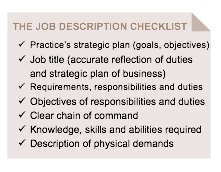Shut the Revolving Door - Part 1: Job Descriptions and Skills Gaps
Assessing the status of your current employees and identifying areas where competence is lacking will improve your hiring process and focus on appropriate training topics.

It is Friday afternoon following a typical week of call-outs, double-booked appointments and emergencies of all kinds. To top it off, one of your technicians just handed you her resignation. How do you respond?
A. “Don’t let the door hit you on the way out.”
B. “Please don’t do this to me. Can’t you stay until I hire a replacement?”
C. You give her the silent treatment while you try to figure out how to stop the insanity.
Although no one would blame you for choosing any of those options, the fact is that they all are reactive responses. If your practice experiences high turnover, it’s time to stop reacting and start being proactive. Although taking the time to be proactive is much easier when you are not embroiled in a scenario like the one just described, view it as an opportunity. By updating your documents and procedures to handle the immediate crisis, you’ll also strengthen your talent management strategy for the future.
This is the first in a series of articles that discuss four key issues to help you close that revolving door for good: job descriptions and skills gaps, compensation and benefits, interviewing and recruiting. This installment explains why accurate job descriptions are a must for hiring and retaining employees and how to identify skills gaps in your team.
RELATED:
- Don't Let Good Employees Quit
- Negotiating Your New Job Contract
Job Descriptions
When was the last time you reviewed your employees’ job descriptions? If it has been a while, consider any hires that went wrong. Was there a disconnect between the job’s description and its actual requirements?
Did you advertise for one skill set when you really needed another? Were factors important for compensation accurate? Job descriptions are key management documents for a host of reasons: They allow you to review performance; manage day-to-day operations; recruit, train and compensate your team; and establish appropriate expectations for the entire staff. Have you ever heard someone say, “That’s not in my job description”? You should review your team’s current job descriptions if, since they were last drafted, you:
- Made changes in operational procedures, such as assigning or shifting responsibilities
- Initiated a new strategic plan for business operations
- Created new positions
- Integrated new technology
- Built a job description around an individual who is leaving or taking on new responsibilities
So where do you start? Begin by comparing the requirements listed in the job descriptions with what people actually do every day. Conduct a job analysis and involve your team in the process. Ask each person to review and edit his or her job description for current relevancy. Supervisors should also review and edit the descriptions.

When conducting a job analysis, consider using a questionnaire about the tasks being performed; face-to-face interviews with the person performing a particular job as well as the supervisor evaluating his or her performance; direct observation of the employee; and log sheets detailing each task and the time spent performing it. Doing so will shed light on expectations of both parties and identify any areas of disconnect between the job description and the reality. See The Job Description Checklist for details of what every job description should include.
Skills Gaps
Reviewing and revising the job description includes updating the required knowledge and skills. Consider performing a skills-gap analysis when you update your job descriptions. Once you have accurate job descriptions, you can identify where skills may be lacking in your team. Gaps fall into three categories:
- Doesn’t know (knowledge gap)
- Doesn’t know how (skills gap)
- Unable to do in practice (practice gap)
Think about the old training adage: Learn one, do one, teach one. Identifying gaps in essential knowledge and skills follows the same idea. Does the person possess the knowledge needed to complete the task, can he or she apply that knowledge to do the task, and can he or she perform the task in real-life situations and show others how to do it as well?
Consider a situation involving new equipment. The technicians do not how to use the new equipment — that is the gap. Does it exist because they lack knowledge about the equipment, have not handled it yet or have not used it in practice on an actual patient?
Identifying gaps in the skills of your team is not relevant only for job descriptions. It also relates to the strategic goals of your business — in other words, what will be needed in the future. While reviewing a job description, you may realize that a new strategic initiative will require new skills and knowledge. That means it’s time to update the job description, inform and train the team, and use this information as you interview potential hires. Skills gaps occur as the faces of the team and the demands of business change.
Suppose the strategic plan is to initiate Fear Free techniques in the exam room. Your team has completed the training modules and is using the techniques in practice. A technician has given notice and you will have to interview for a replacement. Do you include a question about Fear Free techniques during the interviewing process? Is a statement about practicing Fear Free techniques in the job description?
What's In It For You?
Although updating job descriptions and assessing for skills gaps is not a one-and-done process, the rewards are worth the effort. A vacated position presents a good time to review the job description and needed skill set. This new job description should be used for recruiting. After all, you should know what the business needs are before you write a help-wanted ad.
Use the job description to market your open position. Use the skills analysis to develop interview questions and target candidates who can cover any gaps in your current team or provide skills the business will need when it moves forward with the strategic plan.
Once you make that hire, use the job description to coordinate training and subsequent performance appraisals. Updating the job description and skills list as you go along will keep the document relevant and current with the needs of the business.
So, the next time you receive a resignation letter from an employee, welcome the opportunity to update your documents and skills assessment so that the next hire will be exactly what the doctor ordered.
Ms. Dunn is an award-winning speaker, writer and consultant who brings over 40 years of in-the-trenches experience and business education to veterinary management. She is founder and CEO of Snowgoose Veterinary Management Consulting, which helps veterinarians develop strategic plans that consistently produce results.
